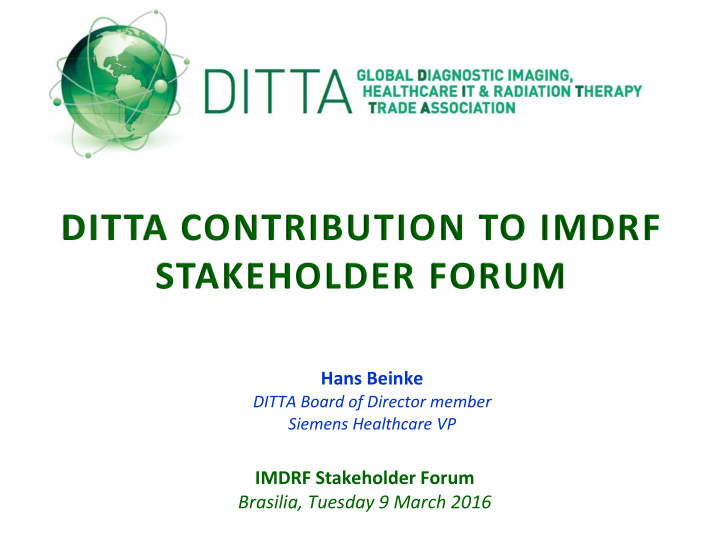



DITTA CONTRIBUTION TO IMDRF STAKEHOLDER FORUM Hans Beinke DITTA Board of Director member Siemens Healthcare VP IMDRF Stakeholder Forum Brasilia, Tuesday 9 March 2016
Key Topics 1. Update on DITTA 2. Good Refurbishment Practices (GRP) Update 3. Outcomes from DITTA Brasilia Workshop on Medical Software 4. DITTA NWIP on Standards 5. DITTA Views on Current Work Items A. Software as a Medical Device (SaMD) B. Medical Device Single Audit Program (MDSAP) C. Regulated Product Submissions (RPS) D. Registries
1. UPDATE ON DITTA
Vice-Chair 2015-2016 Vice-Chair 2015-2016 Chair 2015-2016 Formal Liaison Official NGO
DITTA: 9 WORKING GROUPS DITTA Working Groups MDSAP RPS UDI MSW ENVI GRP World Bank Standardisation WHO
RECENT KEY ACHIEVEMENTS • 2015: DITTA as NGO in official relations with WHO • 2015: DITTA workshops on medical software & standards • 2015: DITTA Brochure on Circular Economy • 2016: DITTA work item on standards proposed • 2016: DITTA workshop on Medical Software during IMDRF Brasilia
2. GOOD REFURBISHMENT PRACTICES (GRP) UPDATE
2. GOOD REFURBISHMENT PRACTICES (GRP) Goals: • Remove ambiguity in terminology and processes associated with “refurbishment.” • Increase awareness of benefits that properly refurbished medical equipment brings to patients and health systems. • Enhance contribution to circular economy of medical device industry. • Provide a structure for lawmakers and regulators when defining legislation and regulations regarding market access for refurbished medical systems. • Enable sale of systems that are refurbished in accordance with the NEMA/MITA GRP standard in any market worldwide if the relevant system type has already been approved in the target market.
2. GOOD REFURBISHMENT PRACTICES (GRP) Current status: • Publication of NEMA/MITA standard “Good Refurbishment Practices for Medical Imaging Equipment.” • Discussing NEMA/MITA 1-2015 with conformity assessment bodies. • Working on updates to existing DITTA GRP Green Paper. Next steps: • Transition NEMA standard to International Standard to maximize utility and benefits to both industry and regulators.
3. OUTCOMES FROM DITTA BRASILIA WORKSHOP ON MEDICAL SOFTWARE
3. OUTCOMES FROM DITTA BRASILIA WORKSHOP ON MEDICAL SOFTWARE Goal: To provide a brief update on progress made at IMDRF level, how medical software are considered in some jurisdictions and provide latest developments on international developments and how those are interlinked to IMDRF work. Attendance: over 100 participants Speakers: 3 from regulators (EU, Brazil and US), 3 from industry (Brazil, EU and US) Key topics discussed: • Progress on IMDRF WI (clinical evaluation) • Jurisdictional differences in Brazil, Europe and USA • Cybersecurity/Data protection • Interoperability • IMDRF WI to provide elements to drive convergence
4. DITTA NWIP ON STANDARDS
4. DITTA NWIP ON STANDARDS • DITTA greatly appreciates the opportunity to contribute to the development on NWIP on Standards. • DITTA understands from conversations with IMDRF members that the DITTA NWIP was well received. • DITTA is keen to discuss any remaining open questions. • DITTA supports IMDRF adoption of this NWIP
5. DITTA VIEWS ON CURRENT WORK ITEMS
A. SOFTWARE AS A MEDICAL DEVICE (SaMD) • DITTA is actively engaged in the current work item SaMD: Clinical Evaluation. • DITTA is fully committed to ensuring that the outcome will be as successful as the previous work items: 1. SaMD: Key Definitions 2. SaMD: Possible Framework for Risk Categorization and Corresponding Considerations 3. SaMD: Application of Quality Management System • DITTA supports IMDRF continued pursuit of this topic
B. MEDICAL DEVICE SINGLE AUDIT PROGRAM (MDSAP) • DITTA applauds the efforts that have gone into developing MDSAP supporting documents, and thanks the jurisdictions that have joined the MDSAP pilot. DITTA is interested in EU’s engagement. • DITTA has actively worked with IMDRF Coordinator from US FDA, to develop a survey to better understand barriers to industry’s participation in the pilot and would be happy to see this launched • DITTA supports the goal of MDSAP, and offers any assistance needed to ensure its success.
C. REGULATED PRODUCT SUBMISSIONS (RPS) – 1 OF 2 • DITTA appreciates the potential benefits of a single submission exchange format for product submissions to multiple regulatory jurisdictions. • However, in order to maximize its potential benefits and ensure its viability, this system must be crafted by regulators and industry in a transparent, open, and collaborative process with clear objectives and a view to an appropriate ROI.
C. REGULATED PRODUCT SUBMISSIONS (RPS) – 2 OF 2 In order to ensure viability of the RPS system and maximize benefits to regulators and industry, DITTA suggests that: • Based on the ToC pilot, define and implement lessons learned. • While the MC has accepted HL7 as a recommendation, the RPS group continues its evaluation of alternative submission exchange formats. • The WG further elaborate on the project plan, key milestones for implementation, the ramp up plan and feedback mechanisms for both regulators and industry. DITTA appreciates opportunities for industry input on CDEs, the ToC, and Technical Exchange format assessment, and is eager for updates on ToC Pilot.
D. REGISTRIES • The draft document, “Patient Registries: Essential Principles” provides a first step in defining consistency, transparency and best practices. • Criteria need to be defined as to when a registry is indicated. • The role registries can play to support regulatory decisions and/or market access should be defined.
DITTA REMAINS SUPPORTIVE OF IMDRF WORK & IS ALWAYS READY TO CONTRIBUTE! THANK YOU FOR YOUR SUPPORT www.globalditta.org
Recommend
More recommend